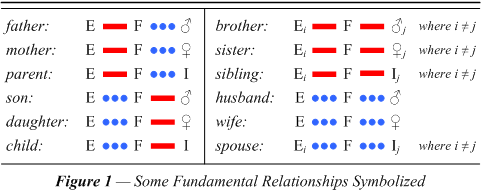
Fundamental relationships. By using the symbols for individuals in the nuclear family it is possible to designate the kinship meaning that resides in some of the vocabulary items of a language. Figure 1 gives some of the simple relationships that are expressed easily in this sign language. In English the sex of the person from whom the relationship is calculated (ego) is not usually important. It comes into play only in the words involving the spousal relationships of “husband” and “wife.”

Extended relationships. The fact that a person can belong to multiple families in two different ways makes for many kinship terms of a less basic kind. Figure 2 illustrates some of the more complicated situations that can arise and be expressed in English. In 2(a) we give the situation where there are several ways to state the same relationship. Whether we are speaking of one of my parent’s brothers, or the husband of one of my parent’s sisters, the term commonly used is my uncle.

In figure 2(b) we give the situation where a language user may choose several very different ways to express a particular relationship. A person’s cousin is nothing more than a parent’s sibling’s child, which some people call a cousin-german. The very special situation in 2(c) illustrates a term for a person who stands simultaneously in two different relationships. Such a situation does not occur very often, but often enough to have developed its own designation. In this case siblings in one family initiate families by marrying siblings in another family, and both sets of parents have children. The offspring in one family are then double-cousins of the offspring in the other.
It appears that whatever the familial relationship might be, there is a way to diagram it using a kinship chain of the sort illustrated. The chain begins with ego (E) and ends with the individual who stands in the relationship of interest. In between the two are symbols for the families and individuals who make the relationship possible.
